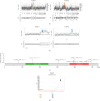A Novel Germline MUTYH Mutation (p.W156∗) in High-Grade Astrocytoma, IDH Mutant
- PMID: 40469416
- PMCID: PMC12136872
- DOI: 10.1155/humu/4321571
A Novel Germline MUTYH Mutation (p.W156∗) in High-Grade Astrocytoma, IDH Mutant
Abstract
Germline mutations in the DNA repair gene E. coli MutY homolog (MUTYH) are established predisposing factors for colorectal polyposis, colorectal carcinoma, and various extracolonic malignancies. Nevertheless, the association between MUTYH mutations and central nervous system (CNS) tumorigenesis remains poorly characterized. In this study, we reported the first identification of a novel c.467G > A (p.W156∗) MUTYH variant in two patients with high-grade astrocytoma, IDH mutant, which was classified as pathogenic. Histopathological evaluation revealed tumor morphologies consistent with either diffuse glioma or giant cell glioblastoma. Comparative analysis with mismatch repair (MMR)-deficient tumors demonstrated that patients carrying MUTYH mutations exhibited microsatellite stability, relatively low tumor mutation burden (TMB), and an immunosuppressive microenvironment, indicating difficulties in benefiting from immunotherapy. Fortunately, gain of Chromosome 7, in association with amplification of the MET gene, was detected, underscoring the possible application of targeted drugs. Integrating previous studies, we summarized germline MUTYH mutations in 11 cases of high-grade neuroepithelial tumors (eight gliomas and three medulloblastomas). This cohort demonstrated a predilection for pediatric and young adult populations without significant gender predominance. Our findings suggested a potential association between germline MUTYH mutations and CNS tumor susceptibility.
Keywords: IDH; MET; MUTYH; astrocytoma; germline mutation.
Copyright © 2025 Lulu Zhang et al. Human Mutation published by John Wiley & Sons Ltd.
Conflict of interest statement
The authors declare no conflicts of interest.
Figures





Similar articles
-
Primary mismatch repair deficient IDH-mutant astrocytoma (PMMRDIA) is a distinct type with a poor prognosis.Acta Neuropathol. 2021 Jan;141(1):85-100. doi: 10.1007/s00401-020-02243-6. Epub 2020 Nov 20. Acta Neuropathol. 2021. PMID: 33216206 Free PMC article.
-
Germline MUTYH mutations and high-grade gliomas: Novel evidence for a potential association.Genes Chromosomes Cancer. 2022 Oct;61(10):622-628. doi: 10.1002/gcc.23054. Epub 2022 May 21. Genes Chromosomes Cancer. 2022. PMID: 35545820 Free PMC article.
-
Novel, improved grading system(s) for IDH-mutant astrocytic gliomas.Acta Neuropathol. 2018 Jul;136(1):153-166. doi: 10.1007/s00401-018-1849-4. Epub 2018 Apr 23. Acta Neuropathol. 2018. PMID: 29687258
-
Grading of adult diffuse gliomas according to the 2021 WHO Classification of Tumors of the Central Nervous System.Lab Invest. 2022 Feb;102(2):126-133. doi: 10.1038/s41374-021-00667-6. Epub 2021 Sep 9. Lab Invest. 2022. PMID: 34504304 Review.
-
IDH-mutant diffuse gliomas: tips and tricks in the era of genomic tumor classification.Histol Histopathol. 2023 Jul;38(7):739-753. doi: 10.14670/HH-18-582. Epub 2023 Jan 9. Histol Histopathol. 2023. PMID: 36651583 Review.
References
-
- Ohtsubo T., Nishioka K., Imaiso Y., et al. Identification of Human MutY Homolog (hMYH) as a Repair Enzyme for 2-Hydroxyadenine in DNA and Detection of Multiple Forms of hMYH Located in Nuclei and Mitochondria. Nucleic Acids Research . 2000;28(6):1355–1364. doi: 10.1093/nar/28.6.1355. - DOI - PMC - PubMed
MeSH terms
Substances
LinkOut - more resources
Full Text Sources
Medical
Molecular Biology Databases
Research Materials
Miscellaneous

